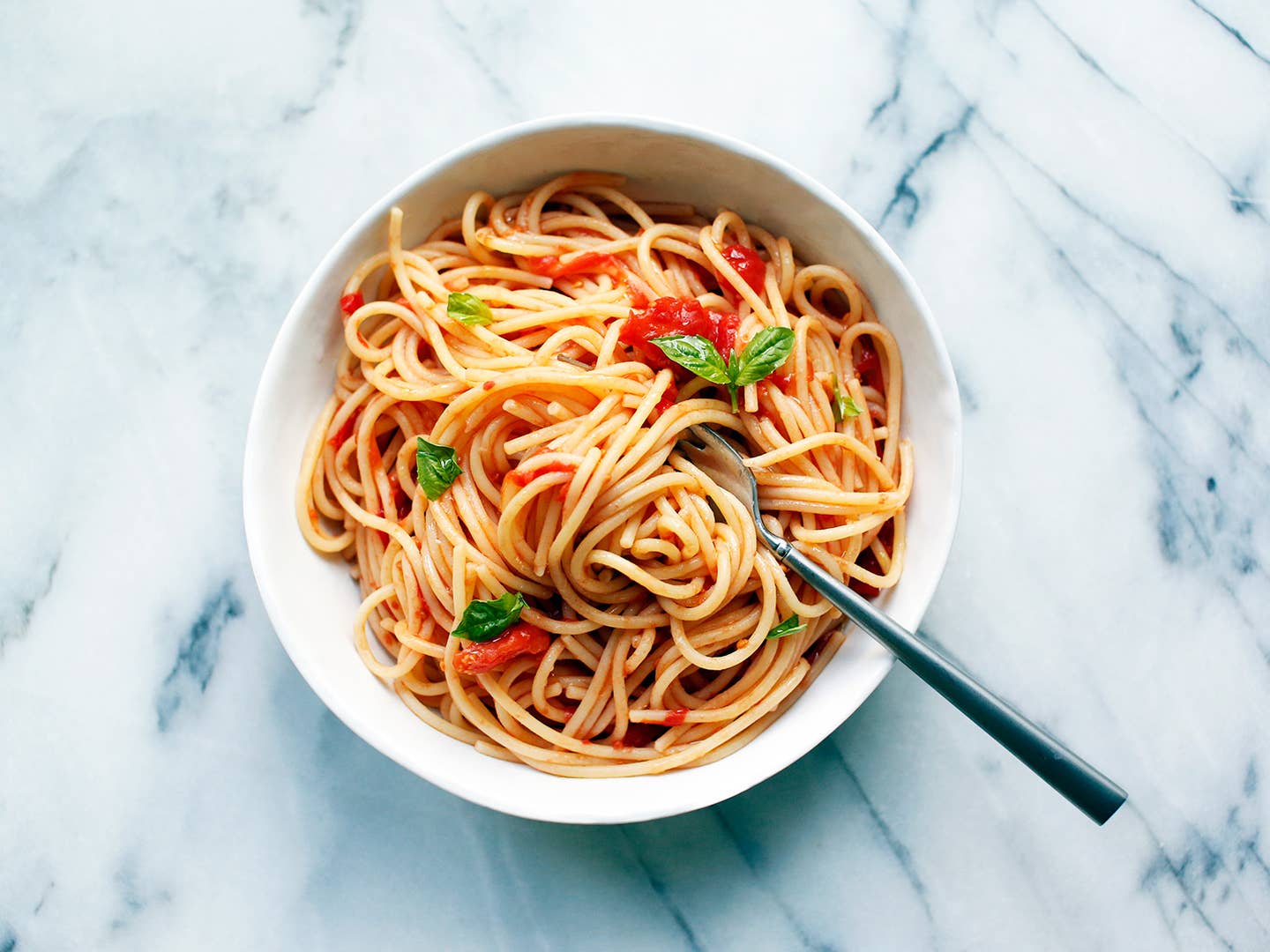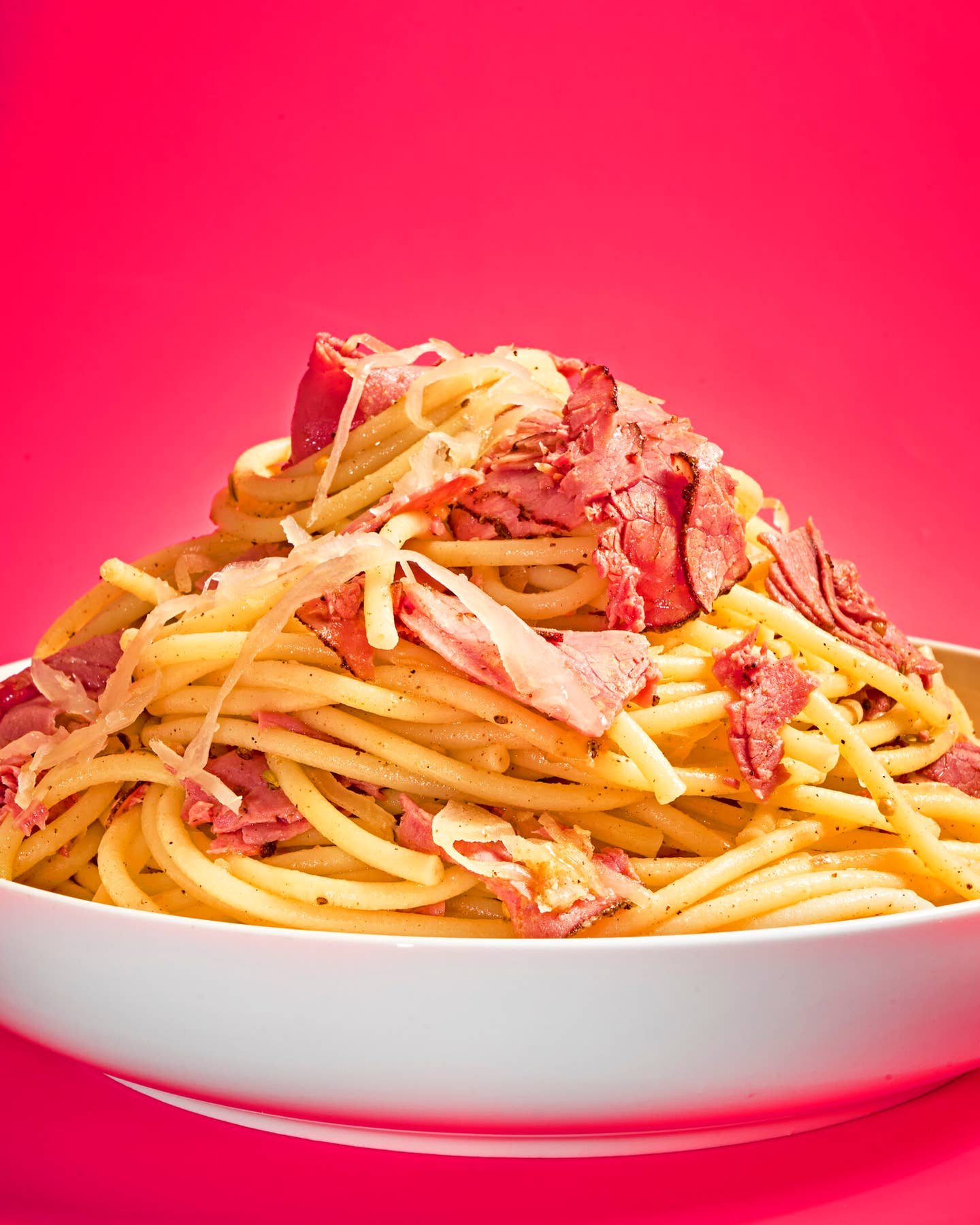
The Path to Perfect Spaghetti al Pomodoro
One obsessed chef thinks he may have found the best possible ingredients and technique for Italy’s most classic pasta
Pasta is automatically associated with the old—old happy nonne, old cities in Italy, old-fashioned recipes. And then there are the age-old debates about who makes certain versions best. Between regional pride and just general pride, it's a distinction many Italians probably would like to give to, well, themselves? In the case of Piedmontese chef Enrico Panero, supremacy of one particular dish is a full-blown conviction.
Currently the corporate executive chef at Eataly Italia, Panero recently embarked on a quest to perfect spaghetti al pomodoro—a dish so simple in makeup and execution that a stellar version, he knew, would all come down to the chosen ingredients. In a rabbit-hole-esque trial and error process—using this type of tomatoes or that type of sea salt, this brand of pasta or that regional olive oil—he feels he's come up with the best possible rendition. His recipe is so good, according to Eataly, that their New York City flagship location incorporated it into the menu at chef Michael Nogera's La Pizza & La Pasta as well, calling it "a revolution in five ingredients."
Unlike alla marinara, which typically involves a sauce made of crushed canned or puréed tomatoes simmered slowly over time, al pomodoro is more of a fresh tomato preparation, barely cooked except to warm it through and bind it with the al dente pasta. Cooks most often rely on ripe, in-season tomatoes, but Panero's use of top-notch tomatoes jarred at the peak of ripeness helps yield more consistent results and allows you to make the dish year-round. Twists on pasta al pomodoro outside Italy might sometimes include finely chopped onion, fresh garlic, cheeses, or different herbs, but to purists, tomatoes, olive oil, and basil are all that's necessary. So smitten with it in all its simplicity, the Eataly chefs call this dish confidently and definitively, "lo spaghetto."
To the surprise of no one, the marriage between tomatoes and pasta is thought to have first taken place in the Italian south, in the city of Naples. The cultivation of tomatoes was most prevalent in a few regions: along the Ligurian coast, in Emilia-Romagna, and in Campania (where Naples is the capital). Although canning tomatoes wouldn’t become a practice until the early 1900s, records from around 1880 show that tomato—often sold and used dried at the time—had begun to become the pasta sauce or condiment of choice.
At the time, when pasta was still largely eaten as a street food, one type of tomato was seemingly the most well-suited to spaghetti al pomodoro: a small, oblong variety called the fiaschetto. (Today it's sold by a few heirloom seed companies and farms.) This quick-growing tomato had a fruitiness that was seen as an ideal match for barely cooked tomato purée (passata di pomodoro) or for pomodoro sauce, but better yet, it was the perfect size to slice in half and dry for preserving.
Once you have the best ingredients, says Nogera, “the dish is really simple. It’s a dish to be replicated at home, with ingredients to keep in the pantry. And yet, [in our version], every ingredient has been carefully thought out in terms of how it will impact the final result.”
Though any high-quality versions of these ingredients—sea salt, dried pasta, extra-virgin olive oil, seasonal basil, and sweet peak-season tomatoes—will make a great bowl of pasta al pomodoro, here are the ingredients Panero swears by.
Sweet Unpeeled Tomatoes
Preserved tomatoes with their skins still intact lend al pomodoro a little more complexity of flavor.
Panero and his team tasted through fresh tomatoes (which are traditional in the dish), but also tomato purée, whole canned tomatoes, and crushed tomatoes—some peeled and others with skins intact. In the end, they chose a little-known type: jarred datterini tomatoes. Italian for "little dates", they are an ancient tomato variety grown in Campania with a sweet flavor and oblong date-like shape. "Even though the unpeeled tomatoes are less sweet and more bitter with the skins on, they help create chunks and texture in the dish because they don't break down into a pulp. Così Com'è brand's are hand-harvested at their peak and processed within a few hours to ensure freshness. You don't need to cook them since they're so fresh-tasting." A few other brands package and sell datterini as well.
Pasta di Gragnano
Coarse, porous spaghetti di Gragnano is the perfect vehicle for showcasing this simple sauce.
Gragnano, a town about 20 miles south of Naples, is known for its robust, artisanal pasta di Gragnano, typically bronze-extruded and historically dried naturally in the winds of the region. Much of it today is slow-dried at low temperatures, and the noodles still maintain a coarse finish and porous texture that allow the sauce to adhere and be absorbed more easily. Panero likes Afeltra brand, founded in 1848. "Their traditional spaghetti is made from 100% Italian wheat and mineral water from the Lattari mountains," Panero says. "To get the right chew, Eataly tested out three different thicknesses: spaghettini (thin), spaghetti (medium), and spaghettoni (extra thick). We ended up choosing the classic spaghetto because it's the most traditional."
Extra-Virgin Olive Oil from Taggiasca Olives
Choose a delicate or medium extra-virgin olive oil—not a spicy or robust one—to let the flavor of the tomatoes shine.
"We chose [taggiasca] olive oil for its compatibility with basil and its subtle flavor—it doesn't have the bite of a Sicilian or Tuscan olive oil, which can sometimes overwhelm the palate." ROI Monocultivar Taggiasca Extra-Virgin Olive Oil is the Eataly chefs' choice (it originated in 1890, "when founder Giuseppe Boeri rented a communal olive oil mill in the hills of Liguria to press local Taggiasca olives," Panero says), but if you can't find that specific brand, look for an extra-virgin olive oil made with the same buttery, mild variety of olives, typically from the Ligurian region.
Sicilian Sea Salt
A medium-coarse grain natural sea salt is the variety of choice for Eataly chefs.
Extracted naturally from fresh seawater, salts with whole crystals, known as "sale integrale," are Panero's preferred style for al pomodoro. "We tasted every salt we carry before settling on a Sicilian salt from Trapani by Il Mercante di Spezie," he says. "It's harvested from the bottom of salt pans (other varieties like Maldon are taken from the top), and does not undergo a drying process, resulting in an earthier, more complex flavor."
Garden Basil
Fragrant fresh basil from your garden or farmers’ market makes all the difference in pomodoro sauce.
Good basil can be surprisingly hard to find, but turning straight to the source—and plucking it right from your own plant or a local farmers’ market—can make a big difference in the flavor it delivers. “In the summer when fresh basil comes into season, we [even use] a special DOP variety from a local farm,” says Panero. Fresh, never dried, the herb first lures you in by the nose with its bright, citrusy flavor, and then rounds out the sweet, unctuous pomodoro sauce.
Keep Reading
Continue to Next Story










